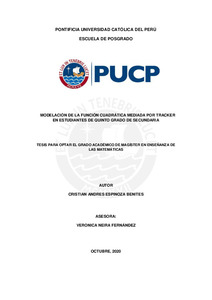| dc.contributor.advisor | Neira Fernández, Verónica | |
| dc.contributor.author | Espinoza Benites, Cristian Andres | |
| dc.date.accessioned | 2021-01-12T22:34:05Z | |
| dc.date.available | 2021-01-12T22:34:05Z | |
| dc.date.created | 2020 | |
| dc.date.issued | 2021-01-12 | |
| dc.identifier.uri | http://hdl.handle.net/20.500.12404/17784 | |
| dc.description.abstract | Según diversos autores, el uso de tecnologías digitales puede mediar y asistir
favorablemente los procesos de Modelación matemática y coinciden además en que
no se han agotado las investigaciones en relación a este tema.
El objetivo de la presente investigación es analizar cómo los estudiantes del quinto
grado de educación secundaria, cuyas edades fluctúan entre 16 y 17 años, modelan
la función cuadrática al resolver una actividad didáctica mediada por Tracker,
destacando el trabajo de cuatro de estos en parejas. La actividad didáctica trata de la
búsqueda del modelo matemático del movimiento vertical de un objeto que se desliza
por un plano inclinado.
Para hacer el análisis del proceso de modelación seguido por los estudiantes,
tomamos como referencia el ciclo de modelación propuesto por Blum y Leiß, que tiene
las fases de la comprensión, simplificación/estructuración, matematización,
resolución matemática, interpretación, validación y comunicación. Para describir el
tránsito entre las fases del ciclo de modelación, es necesario trabajar con la
herramienta de análisis desarrollada por Gallart, que es una guía de preguntas
asociadas al tránsito de fases el ciclo de modelación.
Los resultados obtenidos muestran que, efectivamente, los estudiantes transitan por
las siete fases del ciclo de Modelación matemática. Es necesario precisar que, debido
al uso de Tracker, algunas fases del ciclo de modelación son menos observables y
por tanto más difíciles de describir y esto nos permite reflexionar acerca del rediseño
de las actividades que permitan observar con detalle dichas fases. | es_ES |
| dc.description.abstract | According to various authors, the use of digital technologies can mediate and favorably
support the processes of Mathematical Modeling and also agree that research on this
topic has not been exhausted.
The objective of the present investigation is to analyze how the students of the fifth
grade of secondary education, whose ages fluctuate between 16 and 17 years, model
the quadratic function when solving a didactic activity mediated by Tracker,
highlighting the work of four of these in pairs. The didactic activity deals with the search
for the mathematical model of the vertical movement of an object that slides along an
inclined plane.
To make the analysis of the modeling process followed by the students, we take as a
reference the modeling cycle proposed by Blum and Leiß, which has the phases of
understanding, simplification / structuring, mathematization, mathematical resolution,
interpretation, validation and communication. To describe the transit between the
phases of the modeling cycle, it is necessary to work with the analysis tool developed
by Gallart, which is a guide to questions associated with the phase transit of the
modeling cycle.
the results obtained show that, indeed, the students go through the seven phases of
the Mathematical Modeling cycle. It is necessary to specify that, due to the use of
Tracker, some phases of the modeling cycle are less observable and therefore more
difficult to describe and this allows us to reflect on the redesign of the activities that
allow us to observe these phases in detail. | es_ES |
| dc.language.iso | spa | es_ES |
| dc.publisher | Pontificia Universidad Católica del Perú | es_ES |
| dc.rights | info:eu-repo/semantics/openAccess | es_ES |
| dc.rights.uri | http://creativecommons.org/licenses/by-nc-nd/2.5/pe/ | * |
| dc.subject | Matemáticas--Estudio y enseñanza (Secundaria) | es_ES |
| dc.subject | Tecnología educativa | es_ES |
| dc.subject | Enseñanza con ayuda de computadoras | es_ES |
| dc.title | Modelación de la función cuadrática mediada por tracker en estudiantes de quinto grado de secundaria | es_ES |
| dc.type | info:eu-repo/semantics/masterThesis | es_ES |
| thesis.degree.name | Maestro en Enseñanza de las Matemáticas | es_ES |
| thesis.degree.level | Maestría | es_ES |
| thesis.degree.grantor | Pontificia Universidad Católica del Perú. Escuela de Posgrado | es_ES |
| thesis.degree.discipline | Enseñanza de las Matemáticas | es_ES |
| renati.advisor.dni | 41524960 | |
| renati.advisor.orcid | https://orcid.org/0000-0002-2540-3530 | es_ES |
| renati.author.dni | 40105930 | |
| renati.discipline | 199117 | es_ES |
| renati.juror | Flores Salazar, Jesus Victoria | |
| renati.juror | Neira Fernandez, Veronica | |
| renati.juror | Carrillo Lara, Flor Isabel | |
| renati.level | https://purl.org/pe-repo/renati/level#maestro | es_ES |
| renati.type | http://purl.org/pe-repo/renati/type#tesis | es_ES |
| dc.publisher.country | PE | es_ES |
| dc.subject.ocde | http://purl.org/pe-repo/ocde/ford#5.03.01 | es_ES |






